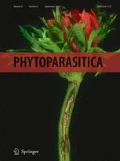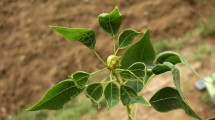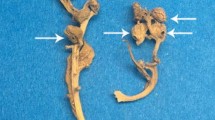Abstract
A gall midge (Diptera, Cecidomyiidae) is reported here for the first time from spikelets of Cortaderia selloana, a prominent alien invasive grass species in southern Europe. The insect is described as a new genus and species, Spanolepis selloanae Gagné. Based on morphological and molecular analyses, the new genus and species are tentatively placed within the supertribe Lasiopteridi and tribe Dasineurini. Its effects on seed production were studied in order to ascertain its effectiveness in limiting sexual reproduction of the invasive plant species. The larvae of S. selloanae feed on the ovaries with a mean seed depletion of 74% in the studied population in northwest Spain. The new species is a potential candidate agent for the effective biological control against C. selloana.





Similar content being viewed by others
References
Adair, R. J. (2005). The biology of Dasineura dielsi Rübsaamen (Diptera: Cecidomyiidae) in relation to the biological control of Acacia cyclops (Mimosaceae) in South Africa. Australian Journal of Entomology, 44, 446–456.
Ahee, J. E., Sinclair, B. J., & Dorken, M. E. (2013). A new species of Stenodiplosis (Diptera: Cecidomyiidae) on florets of the invasive common reed (Phragmites australis) and its effects on seed production. The Canadian Entomologist, 145, 235–246.
Astegiano, M. E., Anton, A. M., & Connor, H. E. (1995). Sinopsis del género Cortaderia (Poaceae) en Argentina. Darwiniana, 33, 43–51.
Barnes, H. F. (1927). British gallmidges. I. The Entomologist’s Monthly Magazine, 63, 211–216.
Barnes, H. F. (1930). On the biology of the gallmidges (Cecidomyidae) attacking meadow foxtail grass (Alopecurus pratensis), including the description of one new species. Annals of Applied Biology, 17, 339–366.
Barnes, H. F. (1931). Gall midges (Cecidomyidae) whose larvae prevent seed production in grasses (Gramineae). Bulletin of Entomological Research, 22, 199–203.
Barnes, H. F. (1939). Grass seed Dasyneura gall midges. Arbeiten über physiologische und angewandte Entomologie aus Berlin-Dahlem, 6, 171–175.
Barnes, H. F. (1946). Gall Midges of Economic Importance. Vol. 2: Gall Midges of Fodder Crops. London: Crosby Lockwood & Son, Ltd.
Blossey, B. (1995). A comparison of various approaches for evaluating potential biological control agents using insects on Lythrum salicaria. Biological Control, 5, 113–122.
Connor, H. E. (1973). Breeding systems in Cortaderia. (Gramineae). Evolution, 27, 663–678.
Connor, H. E. (1981). Evolution of reproductive systems in the Gramineae. Annals of the Missouri Botanical Garden, 1981, 48–74.
Darriba, D., Taboada, G. L., Doallo, R., & Posada, D. (2012). jMODELTEST 2: more models new heuristics and parallel computing. Nature Methods, 9, 772.
Dorchin, N., Harris, K. M., & Stireman, J. O. (2019). Phylogeny of the gall midges (Diptera, Cecidomyiidae, Cecidomyiinae): Systematics, evolution of feeding modes and diversification rates. Molecular Phylogenetics and Evolution, 140, 106602.
Fagúndez, J., & Barrada, M. (2007). Plantas invasoras de Galicia. Bioloxía, distribución e métodos de control. Santiago de Compostela: Dirección Xeral de Conservación da Natureza. Consellería de Medio Ambiente e Desenvolvemento Sostible. Xunta de Galicia.
Fagúndez, J., & Lema, M. (2019). A competition experiment of an invasive alien grass and two native species. Are similar species better competitors? Biological Invasions, 21, 3619–3631.
Failla, A. J., Vasquez, A. A., Hudson, P., Fujimoto, M., & Ram, J. L. (2016). Morphological identification and COI barcodes of adult flies help determine species identities of chironomid larvae (Diptera, Chironomidae). Bulletin of Entomological Research, 106, 34–46.
Felt, E. P. (1908). Appendix D. Pp. 286–422, 489–510, pls. 33–34. In his 23d report of the State Entomologist on injurious and other insects of the State of New York 1907. New York State Museum Bulletin, 124, 5–541.
Folmer, O., Black, M., Hoeh, W., Lutz, R., & Vrijenhoek, R. (1994). DNA primers for amplification of mitochondrial cytochrome c oxidase subunit I from diverse metazoan invertebrates. Molecular Marine Biology and Biotechnology, 3, 294–299.
Gagné, R. J. (1989). The PlantFeeding Gall Midges of North America. Ithaca: Cornell University Press.
Gagné, R. J. (1994). The Gall Midges of the Neotropical Region. Ithaca: Cornell University Press.
Gagné, R. J. (2018). Key to Adults of North America Genera of the Subfamily Cecidomyiinae (Diptera: Cecidomyiidae). Zootaxa, 4392, 401–457.
Gagné, R. J., & Jaschhof, M. (2017). A Catalog of Cecidomyiidae of the World. 4th Edition. Digital. https://www.ars.usda.gov/ARSUserFiles/80420580/Gagne_2017_World_Cat_4th_ed.pdfzzz. Accessed 31 May 2020.
Harradine, A. R. (1991). The impact of pampas grass as weeds in southern Australia. Plant Protection Quarterly, 6, 111–115.
Herrera, M., & Campos, J. A. (2006). El carrizo de la Pampa (Cortaderia selloana) en Bizkaia. Guía práctica para su control. Bizkaia: Instituto de Estudios Territoriales de Bizcaia y Diputación Foral de Bizkaia.
Impson, F. A., Post, J. A., & Hoffmann, J. H. (2013). Impact of the flower-galling midge, Dasineura rubiformis Kolesik, on the growth of its host plant, Acacia mearnsii De Wild, in South Africa. South African Journal of Botany, 87, 118–121.
Keane, R. M., & Crawley, M. J. (2002). Exotic plant invasions and the enemy release hypothesis. Trends in Ecology and Evolution, 17, 164–170.
Kieffer, J. J. (1897). Diagnoses de cécidomyies nouvelles du genre Perrisia Rond. [Dipt.]. Bulletin de la Société Entomologique de France, 1897, 300–301.
Knowles, B., & Ecroyd, C. (1985). Species of Cortaderia (pampas grasses and toetoe) in New Zealand. Forest Research Bulletin, 105, https://doi.org/10.13140/RG.2.2.22061.95209.
Kozlov, A. M., Darriba, D., Flouri, T., Morel, B., & Stamatakis, A. (2019). RAxML-NG: A fast, scalable, and user-friendly tool for maximum likelihood phylogenetic inference. Bioinformatics, 35, 4453–4455.
Kumar, S., Stecher, G., Li, M., Knyaz, C., & Tamura, K. (2018). MEGA X: Molecular Evolutionary Genetics Analysis across computing platforms. Molecular Biology and Evolution, 35, 1547–1549.
Lambrinos, J. G. (2001). The expansion history of a sexual and asexual species of Cortaderia in California, USA. Journal of Ecology, 89, 88–98.
Messing, R. H. (2000). The impact of nontarget concerns on the practice of biological control. In P. Follet & J. J. Dian (Eds.), Nontarget Effects of Biological Control (pp. 45–55). Boston: Springer.
Metcalfe, M. E. (1933). Some Cecidomyidae attacking the seed of Dactylis glomerata L. and Lolium perenne L. Annals of Applied Biology, 20, 327–341.
MTE (2018). Estrategia de gestión, control y posible erradicación del plumero de la pampa (Cortaderia selloana) y otras especies de Cortaderia. Ministerio para la Transición Ecológica, Gobierno de España. https://www.miteco.gob.es/es/biodiversidad/publicaciones/estretegia_cortaderia_tcm30-478427.pdf. Accessed 31 May 2020.
Mühle, E. (1957). Klärende Untersuchungen über das Auftreten von Blütengallmücken an der Wiesenrispe Poa pratensis L. in Deutschland. Zeitschrift für Pflanzenkrankheiten und Pflanzenschutz, 64, 547–550.
Nentwig, W., Bacher, S., Kumschick, S., Pyšek, P., & Vilà, M. (2018). More than “100 worst” alien species in Europe. Biological Invasions, 20, 1611–1621.
Okada, M., Ahmad, R., & Jasieniuk, M. (2007). Microsatellite variation points to local landscape plantings as sources of invasive pampas grass (Cortaderia selloana) in California. Molecular Ecology, 16, 4956–4971.
Pardo-Primoy, J., & Fagúndez, J. (2019). Assessment of the distribution and recent spread of the invasive grass Cortaderia selloana in Industrial Sites in Galicia, NW Spain. Flora, 259, 151465.
Paynter, Q., Fowler, S. V., Hinz, H. L., Memmott, J., Shaw, R., Sheppard, A. W., & Syrett, P. (1996). Are seed-feeding insects of use for the biological control of broom. Proceedings of the IX international symposium on biological control of weeds (pp. 495–501). Cape Town: University of Cape Town.
Post, J. A., Kleinjan, C. A., Hoffmann, J. H., & Impson, F. A. C. (2010). Biological control of Acacia cyclops in South Africa: the fundamental and realized host range of Dasineura dielsi (Diptera: Cecidomyiidae). Biological Control, 53, 68–75.
Rambaut, A., Drummond, A. J., Xie, D., Baele, G., & Suchard, M. A. (2018). Posterior summarisation in Bayesian phylogenetics using Tracer 1.7. Systematic Biology, 67, 901–904.
Rego, M. A., Moreira-Lima, L., Silveira, L. F., & Frahnert, S. (2013). On the ornithological collection of Friedrich Sellow in Brazil (1814–1831), with some considerations about the provenance of his specimens. Zootaxa, 3616, 478–484.
Reuter, E. (1895). Zwei neue Cecidomyinen. Acta Societatis pro Fauna et Flora Fennica 11 (8): 115, pls. I–II.
Ronquist, F., Teslenko, M., van der Mark, P., Ayres, D. L., Darling, A., Höhna, S., et al. (2012). MRBAYES 3.2: Efficient Bayesian phylogenetic inference and model selection across a large model space. Systematic Biology, 61, 539–542.
Saura-Mas, S., & Lloret, F. (2005). Wind effects on dispersal patterns of the invasive alien Cortaderia selloana in Mediterranean wetlands. Acta Oecologica, 27, 129–133.
Schwarzländer, M., Sheppard, A., Shaw, R., Tipping, P. W., & van Klinken, R. D. (2010). Classical biological control for the protection of natural ecosystems. Biological Control, 54, S2–S33.
Sevcik, J., Kasprak, D., Mantic, M., Fitzgerald, S., Sevcikova, T., Tothova, A., & Jaschhof, M. (2016). Molecular phylogeny of the megadiverse insect infraorder Bibionomorpha sensu lato (Diptera). PeerJ, 4, e2563.
Sheppard, A. W., Shaw, R. H., & Sforza, R. (2006). Top 20 environmental weeds for classical biological control in Europe: a review of opportunities, regulations and other barriers to adoption. Weed Research, 46, 93–117.
Sikora, T., Jaschhof, M., Kasprak, D., Mantic, M., & Sevcik, J. (2019). Considerable congruence, enlightening conflict: molecular analysis largely supports morphology-based hypotheses on Cecidomyiidae (Diptera) phylogeny. Zoological Journal of the Linnean Society, 185, 98–110.
Simberloff, D., & Stiling, P. (1996). How risky is biological control? Ecology, 77, 1965–1974.
Simon, C., Frati, F., Beckenbach, A., Crespi, B., Liu, H., & Flook, P. (1994). Evolution, Weighting, and Phylogenetic Utility of Mitochondrial Gene Sequences and a Compilation of Conserved Polymerase Chain Reaction Primers. Annals of the Entomological Society of America, 87, 651–701.
Skuhravá, M., Skuhravy, V., Dauphin, P., & Coutin, R. (2005). Gall midges of France. Les Cécidomyies de France (Diptera: Cecidomyiidae). Mémoires de la Société Linnéenne de Bordeaux, 5, 1–210.
Sylvén, E., & TastásDuque, R. (1993). Adaptive, taxonomic, and phylogenetic aspects of female abdominal features in Oligotrophini (Diptera, Cecidomyiidae), and four new Dasineura species from the western Palearctic. Zoologica Scripta, 22, 277–298.
Tarabon, S., Bertrand, R., Lavoie, C., Vigouroux, T., & Isselin-Nondedeu, F. (2018). The effects of climate warming and urbanised areas on the future distribution of Cortaderia selloana, pampas grass, in France. Weed Research, 58, 413–423.
Van Driesche, R. G., Carruthers, R. I., Center, T., Hoddle, M. S., Hough-Goldstein, J., Morin, L., et al. (2010). Classical biological control for the protection of natural ecosystems. Publications from USDA-ARS/UNL Faculty, p. 883.
Watzl, O. (1939) Studien über Entwicklung und Lebenslauf der Goldhafermücke. Arbeiten über physiologische und angewandte Entomologie aus Berlin-Dahlem, 6, 176–189.
Zhang, Z., Schwartz, S., Wagner, L., & Miller, W. (2000). A greeding algorith for aligning DNA sequences. Journal of Computational Biology, 7, 203–214.
Acknowledgements
We are grateful to Duncan Sivell, Curator (Diptera) Natural History Museum, London for examining specimens of D. festucae and D. trisetae for the presence of scales; Alyssa B. Seemann, Systematic Entomology Laboratory, for the habitus photograph; Sally Gagné, for scanning the pencil drawings; Mike Althaus, Silver Spring, MD, for the final arrangement and labeling of the plates; Mike Gates, Systematic Entomology Laboratory, for identification of the hymenopteran parasitoid; Manuel Pimentel for their comments on the phylogenetic analyses; Miguel Núñez and Daniel Pardo, for their help in the examination of the inflorescences in the original population. Lastly, we appreciate the valuable comments and suggestions of two anonymous reviewers. This work received funding from Xunta de Galicia (grant ED431C 2018/57) and the University of A Coruña. Mention of trade names or commercial products in this publication is solely for the purpose of providing specific information and does not imply recommendation or endorsement by the USDA. USDA is an equal opportunity provider and employer.
Author information
Authors and Affiliations
Corresponding author
Ethics declarations
Conflict of interest
The authors declare that they have no conflict of interest.
Additional information
Publisher’s note
Springer Nature remains neutral with regard to jurisdictional claims in published maps and institutional affiliations.
Electronic supplementary material
ESM 1
(PDF 145 KB)
Rights and permissions
About this article
Cite this article
Fagúndez, J., Gagné, R.J. & Vila, M. A new gall midge species (Diptera, Cecidomyiidae) as a potential candidate for biological control of the invasive plant Cortaderia selloana (Poaceae). Phytoparasitica 49, 229–241 (2021). https://doi.org/10.1007/s12600-020-00844-1
Received:
Accepted:
Published:
Issue Date:
DOI: https://doi.org/10.1007/s12600-020-00844-1




